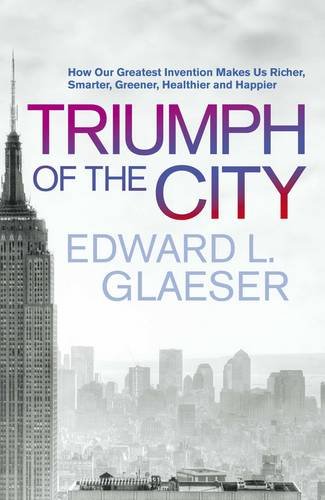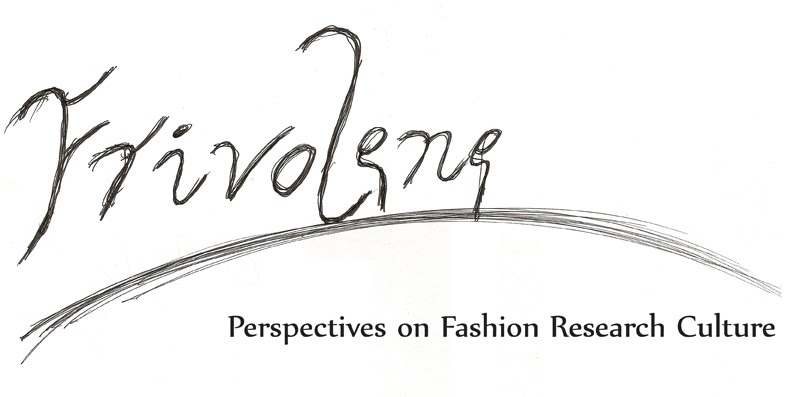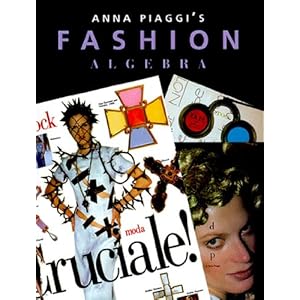Thursday 9 August 2012
Remembering Anna Piaggi
It was sad to learn this week of the death of Anna Piaggi, legendary fashion journalist and editor, as famous for her glamorous and extremely experimental dress-sense, as her fashion reportage. Editor of the now-legendary, short-lived illustration-led Vanity during the 1980s, to many of us she was perhaps most famous for her celebrated DP's (Doppie Pagine/Double Pages) that appeared in Vogue Italia, some of which were complied in a book by Thames & Hudson called Anna Piaggi's Fashion Algebra (which I luckily have a copy of still, but I know is now sadly out-of-print, so maybe track one down in your library, or pick up a perhaps now extortinately priced one on E-bay or Amazon!).
I remember vaguely as a fashion undergraduate at London College of Fashion, long back in the mists of time, being in a class where we were watching a documentary, the title of which I have long forgotten, but in which Anna Piaggi appeared, in all her glorious finery. A hysterical laugh went up from my fellow students, which at the time, and still today, I didn't quite understand. While Piaggi may have appeared a ''figure of fun'' to my peers at the time, I found their response rather peculiar, after all fashion is meant to be fun. And wasn't this also the reason we as students of fashion had signed up to such a course, because this was an industry we perceived as fun and glamorous? Besides, if it wasn't for people such as Piaggi who are prepared to stand up and promote the talents of fashion designers, handbag makers, or milliners, how else is their work to be promoted? In many respects Piaggi has played an important role in both Italian and international fashion circles, using her position as an editor/journalist, and as a true patron, to promote this aspect of fashion culture to its fullest extent. While we are all familiar with the role of the ''best dressed'' as promoted in many magazines, Piaggi took this a stage further, becoming a legendary figure on the front row of fashion shows, a joyful spectacle to keep an eye on, amongst the dreary sea of fashion mavens and PRs in their regulatory black and dark sunglasses. Certainly, the fashion weeks will be a much duller place without Piaggi, and she will be sorely missed, since, despite what my peers thought, every class needs its ''clown'' - after all, it's part of what makes life (and fashion!) worth living.
Wednesday 23 May 2012
The View from CPH
Iconic Hotel
Magasin - Department Store
Colour Combination
Window Display
Traditional Tailoring Shop
Designmuseum Danmark
Labels:
Copenhagen,
fashion,
Fashion Cities,
fashion culture
Wednesday 1 February 2012
Fashioning the City RCA 2012
Getting ready to launch the Call for Papers CFP for the upcoming conference I'm organising at the Royal College of Art in September - Fashioning the City: Exploring Fashion Cultures, Structures and Systems.
For more info and to apply visit: www.fashioningthecity.wordpress.com
Labels:
ALCS,
conference,
fashion,
Fashion Cities,
fashion culture,
RCA
Thursday 12 January 2012
New Year, New Exhibition...

Entrance to the exhibition - Off the Wall
New Year, New Exhibition...it's that time of year again when the annual Work-in-Progress exhibition comes around, which is a key milestone in our academic year here at the RCA. In previous years the fashion and textile's research students (MPhil and PhD) have usually exhibited as part of the larger cohort of fashion and textile MA students. In a new approach, this year as a group we decided to showcase our current working practice within our own self-contained and dedicated gallery area within the much larger exhibition - Off the Wall an exhibition-within-an-exhibition. How successful we have have been you can judge for yourself - since the exhibition is now open everyday from 10.00 - 17.30 until 18th January.
Here below is a brief taster of my own exhibit in the exhibition entitled Antwerpen (Anvers) [Antwerp]: Towards a Case Study, which focuses on one of my ''case study'' cities in my much larger research project looking at the material and materiality of developing that goes into formulating such a case study. The ''mood board'' is a key part of developing fashion collections, and in the spirit of this my exhibit takes the form of a real-life 3-D mood board or collage of material I've collected and is being used to shape and inform my work.

Off the Wall - because everything in the exhibition was exhibited ''off the wall'', suspended from a central hanging rail running through the gallery space

''Mood-board''/''Collage'' of artefacts

Plinth built of fashion magazines Considering the materiality of my research - what are the research materials?

Caramello - The Original Mokatine - bringing to life the sensory experience of Antwerp

Abstract Banners, provided with support from Macroart
Labels:
Antwerp,
fashion exhibitions,
RCA,
Work-in-Progress Exhibition
Wednesday 14 December 2011
The View from Antwerp
Tuesday 6 December 2011
Fash!on ON/OFF
It seems the interest in Fashion Film continues to build, with new outlets for the showcasing of Fashion Film. If your in or around Antwerp in Belgium this week be sure to check out the programme of the first Belgian Fashion Film Festival FASH!ON ON/OFF being hosted in the city at Cinema Zuid/FOMU. Visit www.fashionoff.be for more details on the screenings and talks to include work by Serge Leblon, Henrik Adamson, Ruth Hogben, Peter Lindbergh and Ben Trovato amongst others.






Labels:
Antwerp,
Belgium,
Cinema Zuid,
fashion film. fashion
Tuesday 15 March 2011
Triumph of the City

Much as I enjoy delving into the labyrinth that is fashion theory, I am also aware of its limitations as I progress with my research. Rather than there being one theory or set of ideas, instead I find myself dipping into several, and at this point in time, seemingly disconnected theories, ideas and concepts. Apart from which I am also increasingly aware of the ''healthiness'' of stepping outside of the usual comfort-zones of looking at what seems like the same old references in relation to field of fashion. With this in mind I was glad to have take the time yesterday to attend a lecture hosted at the London School of Economics and Political Science (hardly the usual haunt of the average fashion researcher!).

Ostensibly set up to promote his new book of the same name Professor Edward L Glaeser's lecture ''Triumph of the City: how our greatest invention makes us richer, smarter, greener, healthier, happier'' proved to be a lively and topical discussion on the merits of the city. The main thrust of Glaser's discussion focused on the basic human and social needs through which cities have developed and continue to evolve: that of the need to be in contact, communicate and exchange ideas with our fellow human beings. Glaser referred to the ''paradox'' of today as being that while we are better connected today than ever before, with mobile phones, Twitter and Facebook et al we still retain the need, and desire, to cluster together in one place. He took Silicon Valley in California and also the recent up-risings in the North Africa as examples of situations where clustering together has led to important changes in, respectively, technology and politics. Yet the city as a conduit of ideas is not new, if as Glaeser, suggested we think back to ancient Athens and the cluster of great intellectual thinkers that inhabited the city at that time. Our greatest asset is our ability to learn from those we are amongst, and cities more readily facilitate that on a greater scale, what Glaeser referred to as the city's ''urban edge'' - the bringing of people together. Today this is perhaps more important as ideas become ever more complicated.
While speaking predominately from an economic point of view many of Glaeser's points also have a relevance to the developing cultural aspects of cities, and the thinking behind the ''clustering'' of specific industries and working professionals. In relation to fashion this can be viewed through the clustering of fashion in specific cities, notably the large ''Fashion Capitals'' Paris, London, Milan, New York and Tokyo. These are cities where not only fashion and textile designers are found but also trend forecasters, buyers, agents, fashion editors, photographers model agencies, and of course the events many of them can be found attending. These include shop launches, exhibition openings, catwalk shows and trade fairs. Here fashion professionals can come together and network, exchanging gossip, ideas and new leads about who or what is the next big thing. Glaeser's lecture proved extremely illuminating on the subject of what makes cities dynamic and still attractive to us all, yet it also high-lighted some of the problems cities face too. Very large cities, such as London, while a magnet for drawing in those looking to make their mark also suffer from their popularity. Or rather as Glaeser made clear, city authorities, government bodies and planning experts need to ensure that they are endeavouring to develop and encourage growth and innovation, rather than holding it back. Particularly in the case of London, the lack of capacity in terms of affordable housing and/or office/studio space is a key issue, in part because of a lack of building new property and also re-thinking what kind of properties need to be developed. Here in the UK the idea of the ''tower block'' is something taken out of a nightmare, yet in looking at the uses of space building up, rather than out, may be one of the solutions. Famed for its nurturing of fashion design talent and entrepreneurs in this field, this is something that remains a key consideration for London, and how its reputation for this may be continued in the future.
More Information:
Triumph of the City: http://www.triumphofthecity.com/index.htm
Labels:
Edward Glaeser,
Fashion Cities,
lecture,
LSE,
talk,
urban theory
Subscribe to:
Posts (Atom)














